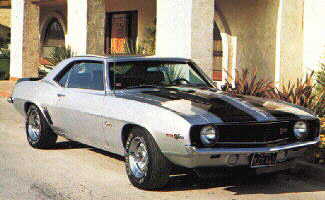
The Z/28
When Chevrolet introduced the Camaro in the summer of 1966 they knew that they had a
contender for the SCCA Trans-Am Racing Series sedan class, created just that year.
Although GM had officially banned racing involvement in 1963 there were plenty of people
at Chevrolet itching to get back into the game, including Chevrolet engineer Vince
Piggins, who may have played a key role in the creation of that class.
![]() "I felt in my activity," Piggens said, "which deals with
product promotion and how to get the most promotional mileage from a car from the
performance standpoint, that we needed to develop a performance image for the Camaro that
would be superior to the Mustang's. After Ford released the Mustang they had about two
years on us before Chevrolet could get the Camaro into the 1967 product line."
"I felt in my activity," Piggens said, "which deals with
product promotion and how to get the most promotional mileage from a car from the
performance standpoint, that we needed to develop a performance image for the Camaro that
would be superior to the Mustang's. After Ford released the Mustang they had about two
years on us before Chevrolet could get the Camaro into the 1967 product line."
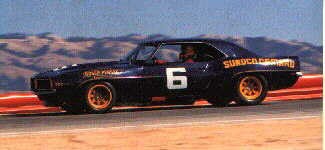
Penske/Donohue Sunoco Camaro, 1969
![]() "Along
comes SCCA in creating the Trans-Am sedan racing class for professional drivers in 1966,
aimed for the 1967 season. I made it a point to have several discussions with SCCA
officials-notably Jim Kaser, John Bishop, and Tracy Byrd - and one thing led to another. I
suggested a vehicle that would fit this class and, I believe - supported by what Chevrolet
might do with the Camaro - it gave them the heart to push ahead and make up the rules,
regulations, and so forth for the Trans-Am series. I feel this was really the creation of
the Trans-Am series as we know it."
"Along
comes SCCA in creating the Trans-Am sedan racing class for professional drivers in 1966,
aimed for the 1967 season. I made it a point to have several discussions with SCCA
officials-notably Jim Kaser, John Bishop, and Tracy Byrd - and one thing led to another. I
suggested a vehicle that would fit this class and, I believe - supported by what Chevrolet
might do with the Camaro - it gave them the heart to push ahead and make up the rules,
regulations, and so forth for the Trans-Am series. I feel this was really the creation of
the Trans-Am series as we know it."
![]() The only problem was that while they had the car, they didn't have an
engine. The Trans Am Series had a displacement limit of 305 cubic inches, and Chevy didn't
have anything close to that. They toyed with the idea of using the 283, but instead they
created a new engine by mating the 4 inch bore block of the 327 (and the 350) with the 3
inch stroke crank of the 283, coming in just under the limit at 302.4 cubic inches. More
details on the 302 are available here.
The only problem was that while they had the car, they didn't have an
engine. The Trans Am Series had a displacement limit of 305 cubic inches, and Chevy didn't
have anything close to that. They toyed with the idea of using the 283, but instead they
created a new engine by mating the 4 inch bore block of the 327 (and the 350) with the 3
inch stroke crank of the 283, coming in just under the limit at 302.4 cubic inches. More
details on the 302 are available here.
![]() They also didn't have a name. In a replay of the struggle to come up
with the name "Camaro" they tried several different approaches, including
Piggens' choice, "Cheetah." The one that came closest to actual use was
"302 Special Performance." In the meantime the bureaucratic workings at
Chevrolet had already assigned a Regular Production Option code to what they were calling
the Special Performance Package. Apparently, RPO Z27 had been assigned to the SS although
it didn't appear under that option until 1969, and the new option was assigned the next
number, Z28. It is not known when the decision was made to use the RPO code for the name,
but probably not until after the first cars were built.
They also didn't have a name. In a replay of the struggle to come up
with the name "Camaro" they tried several different approaches, including
Piggens' choice, "Cheetah." The one that came closest to actual use was
"302 Special Performance." In the meantime the bureaucratic workings at
Chevrolet had already assigned a Regular Production Option code to what they were calling
the Special Performance Package. Apparently, RPO Z27 had been assigned to the SS although
it didn't appear under that option until 1969, and the new option was assigned the next
number, Z28. It is not known when the decision was made to use the RPO code for the name,
but probably not until after the first cars were built.
1967 Z/28 RS
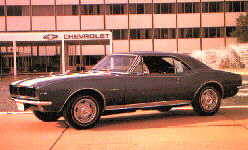
![]() Sometime in the middle of
January the first cars equipped with RPO Z28 appeared, and they carried no external badges
denoting the option. Most of them went to dealerships with an active racing involvement,
such as the Yenko and Penske dealerships in Pennsylvania, Nickey Chevrolet in Chicago, and
Tonkin in Oregon. Chevrolet only sold 602 Z/28s that first year, 398 less than required to
homologate the car under the FIA Group 1 rules. Chevrolet, always a master at bending the
rules, got around the problem by homologating the 350 car under Group 1 rules, then
qualifying the car with the Z/28 option under Group 2 rules.
Sometime in the middle of
January the first cars equipped with RPO Z28 appeared, and they carried no external badges
denoting the option. Most of them went to dealerships with an active racing involvement,
such as the Yenko and Penske dealerships in Pennsylvania, Nickey Chevrolet in Chicago, and
Tonkin in Oregon. Chevrolet only sold 602 Z/28s that first year, 398 less than required to
homologate the car under the FIA Group 1 rules. Chevrolet, always a master at bending the
rules, got around the problem by homologating the 350 car under Group 1 rules, then
qualifying the car with the Z/28 option under Group 2 rules.
1969 Z/28

![]() The plan worked, with the Camaro
taking the title in '68 and '69. The Z/28 got its own identification badges in '68 and the
sales took off, with 7,098 of the total 235,147 Camaros sold that year carrying the Z/28
option. They did even better in '69 when 20,302 Z/28s out of 243,085 were sold.
The plan worked, with the Camaro
taking the title in '68 and '69. The Z/28 got its own identification badges in '68 and the
sales took off, with 7,098 of the total 235,147 Camaros sold that year carrying the Z/28
option. They did even better in '69 when 20,302 Z/28s out of 243,085 were sold.
![]() As originally conceived, the Special Performance Equipment Option
consisted of the F41 heavy-duty suspension, front disc brakes, metallic-lined rear drum
brakes, 24:1 quick-ratio steering gear, 15x6 Rally wheels with 7.75x15 tires, a special
air intake, the M21 close-ratio 4-speed transmission, and the 302 V8 engine. When the
option hit the order sheets, however, it didn't include the brakes or the transmission.
You were required to add these options seperately, adding another three to four hundred
dollars to the standard four hundred dollar price of the Z/28 option.
As originally conceived, the Special Performance Equipment Option
consisted of the F41 heavy-duty suspension, front disc brakes, metallic-lined rear drum
brakes, 24:1 quick-ratio steering gear, 15x6 Rally wheels with 7.75x15 tires, a special
air intake, the M21 close-ratio 4-speed transmission, and the 302 V8 engine. When the
option hit the order sheets, however, it didn't include the brakes or the transmission.
You were required to add these options seperately, adding another three to four hundred
dollars to the standard four hundred dollar price of the Z/28 option.
1968 Z/28
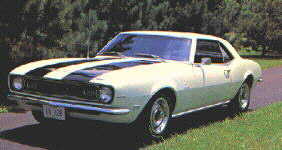
![]() For '68, the engine stayed
basically the same, but received the new large journal crankshaft. A quicker steering
ratio became standard, 21.4:1, with an even quicker ratio as an option, 17.9:1. The D80
spoiler option became available, as did a thicker front sway bar. The Z/28 got the new
five leaf rear springs along with the rest of the Camaros, and a better suspension.
For '68, the engine stayed
basically the same, but received the new large journal crankshaft. A quicker steering
ratio became standard, 21.4:1, with an even quicker ratio as an option, 17.9:1. The D80
spoiler option became available, as did a thicker front sway bar. The Z/28 got the new
five leaf rear springs along with the rest of the Camaros, and a better suspension.
302 Crossram
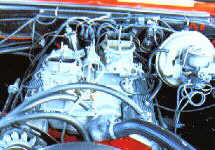
![]() There were also two important
"Service Options" available, which meant you had to buy them from the dealer's
parts counter and install them yourself. These were the four wheel disc brake package, and
the dual four barrel intake. This intake was never offered as a Regular Production Option,
and is not considered original equipment on any car.
There were also two important
"Service Options" available, which meant you had to buy them from the dealer's
parts counter and install them yourself. These were the four wheel disc brake package, and
the dual four barrel intake. This intake was never offered as a Regular Production Option,
and is not considered original equipment on any car.
Chevrolet Advertisement

![]() The
1969 Z/28 was different from the '68, with quite a few pieces of optional and standard
equipment coming and going during the extended production run. The ZL2 Special Ducted Hood
became available in mid-December. Contrary to popular belief, Chevrolet never called it
"Cowl Induction." That name appeared on a similar system for the 1970 Chevelle.
Chevy advertised it as the "Super Scoop", and later began referring to it as
"air induction" in internal memos relating to the Pace Car replicas. The
previous Z/28 system ducted the air from the cowl area through the firewall.
The
1969 Z/28 was different from the '68, with quite a few pieces of optional and standard
equipment coming and going during the extended production run. The ZL2 Special Ducted Hood
became available in mid-December. Contrary to popular belief, Chevrolet never called it
"Cowl Induction." That name appeared on a similar system for the 1970 Chevelle.
Chevy advertised it as the "Super Scoop", and later began referring to it as
"air induction" in internal memos relating to the Pace Car replicas. The
previous Z/28 system ducted the air from the cowl area through the firewall.
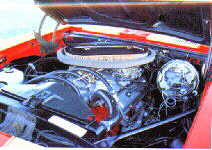
![]() This hood was also available in fiberglass to work
with the crossram intake manifold, which was again a service option in '69. This hood had
an oval mating area on the underside to fit the oval air cleaner of the crossram. This
package was offered over the counter in order to homologate it for racing.
This hood was also available in fiberglass to work
with the crossram intake manifold, which was again a service option in '69. This hood had
an oval mating area on the underside to fit the oval air cleaner of the crossram. This
package was offered over the counter in order to homologate it for racing.
![]() Other changes for '69 include a
four-bolt main bearing block and Firestone E70-15 Sports Car 200 tires in place of the
standard Goodyears. The four wheel disc brake package became a standard option under RPO
JL8, although only 206 were ordered this way. There were many more ordered as a service
option, and the two systems were not the same. You can find out the differences in the Rare Car section. In addition, the RPO NC8 Chambered Exhaust option
came and went, because it was both popular (with the customers) and unpopular (with the
police) at the same time.
Other changes for '69 include a
four-bolt main bearing block and Firestone E70-15 Sports Car 200 tires in place of the
standard Goodyears. The four wheel disc brake package became a standard option under RPO
JL8, although only 206 were ordered this way. There were many more ordered as a service
option, and the two systems were not the same. You can find out the differences in the Rare Car section. In addition, the RPO NC8 Chambered Exhaust option
came and went, because it was both popular (with the customers) and unpopular (with the
police) at the same time.
![]() The Z/28 302 engine was rated by
the factory at 290hp. Although everyone says that the engine was underrated, I have not
seen any tests done to determine the actual horsepower. Estimates have ranged from 300 hp
to 500 hp. The numbers that have been documented come from the actual Penske/Donohue race
cars.
The Z/28 302 engine was rated by
the factory at 290hp. Although everyone says that the engine was underrated, I have not
seen any tests done to determine the actual horsepower. Estimates have ranged from 300 hp
to 500 hp. The numbers that have been documented come from the actual Penske/Donohue race
cars.
![]() Pat Ryan of Unfair Advantage Racing
owns one of the original 1967 cars. He still races it it the Sports Car Vintage Racing
Association. The engine, as prepared by Traco engineering, puts out 398 hp at 6,800 rpm.
In 1968 the Traco engines put out varying horsepower in different stages of tune, but I
have seen the following numbers: 441.5 @ 7,400, 419.5 @ 6,800, and 458 @ 7,100. These
figures were taken with the single four barrel setup.
Pat Ryan of Unfair Advantage Racing
owns one of the original 1967 cars. He still races it it the Sports Car Vintage Racing
Association. The engine, as prepared by Traco engineering, puts out 398 hp at 6,800 rpm.
In 1968 the Traco engines put out varying horsepower in different stages of tune, but I
have seen the following numbers: 441.5 @ 7,400, 419.5 @ 6,800, and 458 @ 7,100. These
figures were taken with the single four barrel setup.
![]() So how powerful was the production
302? Probably around 350-400 horsepower would be a good guess. No bad from 302 cubic
inches!
So how powerful was the production
302? Probably around 350-400 horsepower would be a good guess. No bad from 302 cubic
inches!
![]() The Z/28 package had several
significant changes through the extended production run. Here are the five different
versions offered:
The Z/28 package had several
significant changes through the extended production run. Here are the five different
versions offered:
1969 RPO Z/28 CHANGES
(These changes were taken from dealer order book revisions from 1969)
Version A: Dated September 26, 1968
![]() Z/28 Special Performance Package: Model 12437 only. Includes 302"
V8 engine, dual exhaust with deep-tone mufflers, special front and rear suspension, rear
bumper guards, heavy-duty radiator and temperature-controlled fan, quick ratio steering,
15 x 7 rally wheels, E70 x 15 special white lettered tires, 3.73 ratio axle and special
rally stripes on hood and rear deck. Available only when 4-speed trans., power disc brakes
are ordered. Positraction rear axle recommended.
Z/28 Special Performance Package: Model 12437 only. Includes 302"
V8 engine, dual exhaust with deep-tone mufflers, special front and rear suspension, rear
bumper guards, heavy-duty radiator and temperature-controlled fan, quick ratio steering,
15 x 7 rally wheels, E70 x 15 special white lettered tires, 3.73 ratio axle and special
rally stripes on hood and rear deck. Available only when 4-speed trans., power disc brakes
are ordered. Positraction rear axle recommended.
Price 458.15
Note: no tach required
Version B: Dated October 18, 1968
![]() Z/28 Special Performance Package: Model 12437 only. Includes 302"
V8 engine with bright accents; chambered dual exhaust system; Z/28 emblems on grille,
front fender and rear panel; special front and rear suspension; rear bumper guards;
heavy-duty radiator and temperature-controlled fan; quick ratio steering; 15 x 7 wheels
with trim rings; E70 x 15 special white lettered blackwall tires and special paint stripes
on hood and rear deck. Avail. only when 4-speed transmission, power front or four-wheel
disc brakes are ordered. Positraction rear axle recommended.
Z/28 Special Performance Package: Model 12437 only. Includes 302"
V8 engine with bright accents; chambered dual exhaust system; Z/28 emblems on grille,
front fender and rear panel; special front and rear suspension; rear bumper guards;
heavy-duty radiator and temperature-controlled fan; quick ratio steering; 15 x 7 wheels
with trim rings; E70 x 15 special white lettered blackwall tires and special paint stripes
on hood and rear deck. Avail. only when 4-speed transmission, power front or four-wheel
disc brakes are ordered. Positraction rear axle recommended.
Price 458. 15
Note: chambered exhaust part of option. Notice JL-8 (four-wheel discs) recommended
Version C: Dated January 2, 1969
![]() Z/28 Special Performance Package: Model 12437 only. Includes 302"
V8 engine with bright accents; dual exhausts; Z/28 emblems on grille, front fender and
rear panel; special front and rear suspension; rear bumper guards; heavy-duty radiator and
temperature-controlled fan; quick ratio steering; 15 x 7 wheels with trim rings; E70 x 15
special white lettered blackwall tires and special paint stripes on hood and deck. Avail.
only when tachometer gauge or special instrumentation, 4-speed trans., power front or
four-wheel disc brakes are ordered. Positraction rear axle recommended.
Z/28 Special Performance Package: Model 12437 only. Includes 302"
V8 engine with bright accents; dual exhausts; Z/28 emblems on grille, front fender and
rear panel; special front and rear suspension; rear bumper guards; heavy-duty radiator and
temperature-controlled fan; quick ratio steering; 15 x 7 wheels with trim rings; E70 x 15
special white lettered blackwall tires and special paint stripes on hood and deck. Avail.
only when tachometer gauge or special instrumentation, 4-speed trans., power front or
four-wheel disc brakes are ordered. Positraction rear axle recommended.
Price 473.95
Note: tach now required; no longer has chambered exhaust as a standard feature
Version D: Dated April 1,1969
![]() Z/28 Special Performance Package: Model 12437 only. Includes 302"
V8 engine with bright accents; dual exhausts; Z/28 emblems on grille, front fender and
rear panel; special front and rear suspension; rear bumper guards; heavy-duty radiator and
temperature-controlled fan; quick ratio steering; 15 x 7 wheels with special center caps
and trim rings; E70 x 15 special white lettered blackwall tires; auxiliary front valance
panel and rear deck spoiler plus special paint stripes on hood and rear deck. Available
only when tachometer gauge or special instrumentation, 4-speed transmission, power front
or four-wheel disc brakes are ordered. Positraction rear axle recommended.
Z/28 Special Performance Package: Model 12437 only. Includes 302"
V8 engine with bright accents; dual exhausts; Z/28 emblems on grille, front fender and
rear panel; special front and rear suspension; rear bumper guards; heavy-duty radiator and
temperature-controlled fan; quick ratio steering; 15 x 7 wheels with special center caps
and trim rings; E70 x 15 special white lettered blackwall tires; auxiliary front valance
panel and rear deck spoiler plus special paint stripes on hood and rear deck. Available
only when tachometer gauge or special instrumentation, 4-speed transmission, power front
or four-wheel disc brakes are ordered. Positraction rear axle recommended.
Price 506.60
Note: spoilers now required
Version E: Dated September 18, 1969
![]() Z/28 Special Performance Package: Model 12437 only. Includes 302"
V8 engine with bright accents; dual exhausts with bright tips; Z/28 emblems on grille,
front fender and rear panel; special front and rear suspension; rear bumper guards;
heavy-duty radiator and temperature-controlled fan; quick ratio steering; 15 x 7 wheels
with special center caps and trim rings; E70 x 15 special white lettered blackwall tires;
auxiliary front valance panel and rear deck spoiler plus special paint stripes on hood and
rear deck. Available only when tachometer gauge or special instrumentation, 4-speed
transmission, power front disc brakes are ordered. Positraction rear axle recommended.
Z/28 Special Performance Package: Model 12437 only. Includes 302"
V8 engine with bright accents; dual exhausts with bright tips; Z/28 emblems on grille,
front fender and rear panel; special front and rear suspension; rear bumper guards;
heavy-duty radiator and temperature-controlled fan; quick ratio steering; 15 x 7 wheels
with special center caps and trim rings; E70 x 15 special white lettered blackwall tires;
auxiliary front valance panel and rear deck spoiler plus special paint stripes on hood and
rear deck. Available only when tachometer gauge or special instrumentation, 4-speed
transmission, power front disc brakes are ordered. Positraction rear axle recommended.
Price 522.40
Note: notice chrome tail pipes standard on or about May 19, 1969.
Version F: Dated November 3, 1969
![]() Z/28 Special Performance Package: Model 12437 only. Includes 302"
V8 engine with bright accents; dual exhausts with bright tips; Z/28 emblems on grille,
front fender and rear panel; special front and rear suspension; rear bumper guards;
heavy-duty radiator and temperature-controlled fan; quick ratio steering; 15 x 7 wheels
with special center caps and trim rings; E70 x 15 special white lettered blackwall tires;
auxiliary front valance panel and rear deck spoiler plus special paint stripes on hood and
rear deck. Available only when tachometer gauge or special instrumentation, 4-speed
transmission, power front disc brakes are ordered. Positraction rear axle recommended.
Z/28 Special Performance Package: Model 12437 only. Includes 302"
V8 engine with bright accents; dual exhausts with bright tips; Z/28 emblems on grille,
front fender and rear panel; special front and rear suspension; rear bumper guards;
heavy-duty radiator and temperature-controlled fan; quick ratio steering; 15 x 7 wheels
with special center caps and trim rings; E70 x 15 special white lettered blackwall tires;
auxiliary front valance panel and rear deck spoiler plus special paint stripes on hood and
rear deck. Available only when tachometer gauge or special instrumentation, 4-speed
transmission, power front disc brakes are ordered. Positraction rear axle recommended.
Price 522.40
Note: These are used for comparison. There are many documented cars which do not
fall into these guidelines. Anything could have happened on the assembly line.
![]() Other changes occurred in the
'69 model year. Early '69 Z/28s used a Y55 top post battery, but Chevy went to a side post
Y77 in February. A few months later this was replaced by the Y89, which used the same bolt
size for the positive and negative terminals.
Other changes occurred in the
'69 model year. Early '69 Z/28s used a Y55 top post battery, but Chevy went to a side post
Y77 in February. A few months later this was replaced by the Y89, which used the same bolt
size for the positive and negative terminals.
![]() The Z/28 got single piston calipers on the disc brakes, as opposed to
the four piston calipers in '67 and '68. You could also order the factory 4 wheel disc
brake systerm, RPO JL8, but there were problems with parts availability during the year,
and there were several stop orders issued, delaying delivery of the cars.
The Z/28 got single piston calipers on the disc brakes, as opposed to
the four piston calipers in '67 and '68. You could also order the factory 4 wheel disc
brake systerm, RPO JL8, but there were problems with parts availability during the year,
and there were several stop orders issued, delaying delivery of the cars.
![]() The console and guages were the same as used in 1968, but the woodgrain
pattern was different. In 1969 rosewood replaced walnut on all the woodgrain accents.
The console and guages were the same as used in 1968, but the woodgrain
pattern was different. In 1969 rosewood replaced walnut on all the woodgrain accents.
![]() The stripes were larger on the rear deck in '69 than on previous years.
You could also order your Z/28 with the stripes deleted.
The stripes were larger on the rear deck in '69 than on previous years.
You could also order your Z/28 with the stripes deleted.
![]() The Z/28 became a legend almost
from the start. While the new Camaros are wonderful cars, there is nothing quite like a
1969 Z/28!
The Z/28 became a legend almost
from the start. While the new Camaros are wonderful cars, there is nothing quite like a
1969 Z/28!